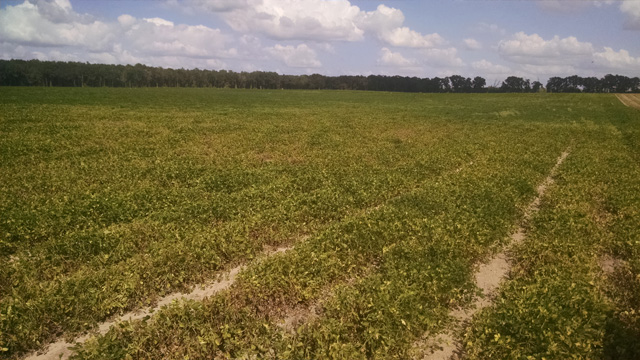After back to back mild winters, the 2017 growing season has been a banner year for pests. Prolonged cold weather normally diminishes pest populations, but this year pests of all types survived winter with populations that have increased dramatically.
Most of the growing season, whiteflies were the major concern across fruit, vegetable and agronomic crops. They wreaked havoc in tomatoes, cotton, and even soybeans, with lasting effects in regards to disease and defoliation. As the growing season is winding down, another type of pest is making its presence known this year – plant-parasitic nematodes!
Several species of nematodes pose problems in crops, examples include the sting, reniform, and root-knot nematodes. With harvest well underway, most late-planted cotton and peanut crops are maturing and have started to senesce or deteriorate. As the plants naturally mature, nematode pressure is becoming more and more apparent. The month of June, with cloudy days and rainfall nearly every day, created issues for farmers. Weather delayed fertilizer applications in many areas, and in some cases caused the loss of fertility through leaching. This added plant stress enhanced nematode damage even in fields with good crop rotation that had been treated with nematicides.

Jackson County peanut field with declining plant health two weeks prior to harvest, had been treated with Telone II with a good rotation history. Photo by Ethan Carter.
Serious nematode damage is appearing in both peanut and cotton fields this year. Fields with mild symptoms in early summer are becoming more and more apparent as the season is coming to an end. One of the easiest nematode problems to identify in the field is damage caused by the presence of root-knot nematodes that create root galls as seen in the photo below. There are two root-knot species that threaten row crops, one affecting peanut and the other affects cotton. There is no host overlap between the two species, which is why peanut and cotton make good rotation partners.
There are root-knot resistant cultivars that have been developed for both peanut and cotton, which can be used in fields with a known history of nematode damage. These varieties can be used with minimal inputs (nematicides) compared to non-resistant lines in fields with high pressure.

Well developed cotton root system of a nematode resistant line (left), compared to the root system of a non-resistant line exhibiting stunted lateral branching and galling (right). Photo by Doug Mayo.
Resistant cultivar lines can provide dramatic differences in crop health when planted in fields with high nematode pressure. The resistant plants continue to grow and function unhindered, whereas the susceptible plants are stressed from nematode feeding and the lack of nutrient uptake through the damaged root system. The following two images come from a cotton field where the resistant cultivar DP 1747NR was planted through the middle of a traditional non-resistant variety.

Aerial shot of a cotton field in Jackson County with a nematode resistant line planted through the middle, a susceptible variety is planted on the left and right. Photo by Doug Mayo
Both the resistant and non-resistant variety are mid to full-maturity varieties. The above image gives the appearance that the majority of the field had been defoliated. In the image below, taken just above the plants, you can see that is not the case. The nematode resistant cotton plants on the left side of the photo are just not as stressed by the nematode feeding damage to the root system.

Jackson County field with nematode resistant cotton on the left, susceptible variety on the right. Photo by Doug Mayo.
Nematode samples from fields can be submitted to a lab for identification, using the Nematode Assay Form. Seed availability of some nematode resistant cultivars of peanut and cotton are limited at this point, but there are options. It is important to determine which fields have highest populations of nematodes this fall. This information can assist with crop rotation, cultivar selection, and nematicide selections for next season.
For more information regarding nematodes in agronomic crops, check out the following publications:
-
Management of Plant-Parasitic Nematodes in Florida Cotton Production
-
Management of Plant-Parasitic Nematodes in Florida Field Corn Production
-
Management of Plant-Parasitic Nematodes in Florida Soybean Production
- Provisional Nitrogen Fertilization Recommendation for Florida Cotton for the 2025 Season - June 20, 2025
- NFREC-Quincy Row Crop Field Day – July 21 - June 20, 2025
- NFREC-Marianna Peanut Field Day – August 14 - June 20, 2025

